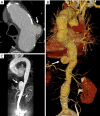Intramural hematoma and penetrating ulcer in the descending aorta: differences and similarities
- PMID: 31463208
- PMCID: PMC6687957
- DOI: 10.21037/acs.2019.07.05
Intramural hematoma and penetrating ulcer in the descending aorta: differences and similarities
Abstract
Acute aortic syndromes include a variety of overlapping clinical and anatomic diseases. Intramural hematoma (IMH), penetrating atherosclerotic ulcer (PAU), and aortic dissection can occur as isolated processes or can be found in association. All these entities are potentially life threatening, so prompt diagnosis and treatment is of paramount importance. IMH and PAU affect patients with atherosclerotic risk factors and are located in the descending aorta in 60-70% of cases. IMH diagnosis can be correctly made in most cases. Aortic ulcer is a morphologic entity which comprises several entities-the differential diagnosis includes PAU, focal intimal disruptions (FID) in the context of IMH evolution and ulcerated atherosclerotic plaque. The pathophysiologic mechanism, evolution and prognosis differ somewhat between these entities. However, most PAU are diagnosed incidentally outside the acute phase. Persistent pain despite medical treatment, hemodynamic instability, maximum aortic diameter (MAD) >55 mm, significant periaortic hemorrhage and FID in acute phase of IMH are predictors of acute-phase mortality. In these cases, TEVAR or open surgery should be considered. In non-complicated IMH or PAU, without significant aortic enlargement, strict control of cardiovascular risk factors and frequent follow-up imaging appears to be a safe management strategy.
Keywords: Intramural hematoma (IMH); acute aortic syndrome (AAS); aortic ulcer (AU); focal intimal disruption; penetrating atherosclerotic ulcer (PAU).
Conflict of interest statement
Conflicts of Interest: The authors have no conflicts of interest to declare.
Figures











References
-
- Gore I. Pathogenesis of dissecting aneurysm of the aorta. AMA Arch Pathol 1952;53:142-53. - PubMed
Publication types
LinkOut - more resources
Full Text Sources
